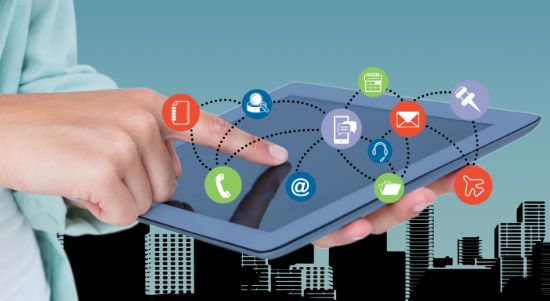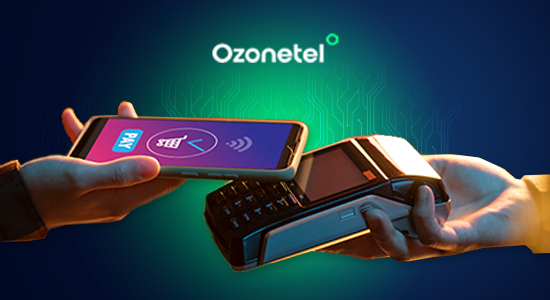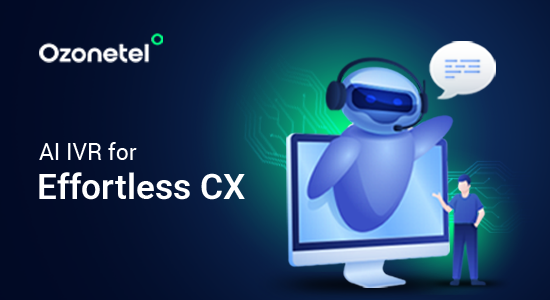- Resources
- Omnichannel Customer Experience: The Complete Guide for 2025
Omnichannel Customer Experience: The Complete Guide for 2025

Omnichannel customer experience (CX) is about providing a seamless and integrated experience for your customers across all communication channels—whether online or offline. It connects platforms like websites, apps, social media, and physical stores, enabling customers to move between them effortlessly.
Without omnichannel integration, customers often need to re-explain their issues when switching from an app to a call center or store. This disrupts their experience and creates dissatisfaction. Whereas, with an omnichannel CX, your team has access to a unified view of customer interactions, allowing for smooth transitions and quicker resolutions.
Read along as we discuss more about what omnichannel customer experience is and how you can implement it in your organization.
In this article, we will explore:
- 1.What Is Omnichannel Customer Experience?
- 2. Why Does Omnichannel Customer Experience Matter?
- 3. Omnichannel vs Multichannel: Key Differences
- 4.7 Benefits of Omnichannel Customer Experience
- 5.Tips to Deliver Exceptional Omnichannel Customer Experience
- 6.CSAT vs DSAT Best Practices in Implementing Omnichannel Strategy
- 7.Top Examples of Omnichannel Customer Experience
- 8.Role of AI in Omnichannel Customer Experience
What Is Customer Onboarding?
The customer onboarding process focuses on nurturing new customers—ensuring they are properly set up, familiar with your product, and comfortable using it. The purpose of customer onboarding is to provide value to your consumers as soon as possible so that they continue to return to your product and quickly embrace it as part of their regular work routine.
What Is Omnichannel Customer Experience?
Omnichannel customer experience refers to creating a seamless and consistent interaction for your customers across all communication channels and touchpoints, including websites, apps, social media, and in-store visits. It’s not just about having multiple channels; it’s about integrating them so your customers can move between platforms effortlessly.
For example, if a customer enquiries about a product via email, a support agent can respond promptly and seamlessly continue the conversation over WhatsApp if needed. This approach creates a consistent and satisfying customer experience
Why Does Omnichannel Customer Experience Matter?
An omnichannel customer experience ensures your customers have a seamless interaction with your brand across all channels—online and offline. This is important because an omnichannel experience aligns with how people shop and engage today. Here is some data to back these claims:
- 90% of customers expect a consistent experience across all touchpoints, whether it’s a website, app, or physical store.
- 88% of Gen Z expect brands to deliver cohesive experiences across digital and physical channels, but it’s not limited to younger generations.
- About 78% of baby boomers report dissatisfaction when they have to restart conversations with a brand.
- Customers, on average, interact across several touchpoints – 6 per purchase journey, and sometimes up to 20 for bigger decisions.
- Campaigns using multiple channels have an 18.96% engagement rate, compared to just 5.4% for single-channel campaigns.
- 66% of customers prefer choosing their path to completing a task. This could involve starting on a mobile app, visiting a store to see products in person, and completing the purchase on a desktop.
- 91% of customers say they are more likely to do business with a company that remembers their preferences and provides tailored recommendations.
Omnichannel vs Multichannel: Key Differences

While both omnichannel and multichannel strategies involve using various communication platforms, they differ significantly in how these platforms are connected and how they serve the customer.
| Aspect | Omnichannel | Multichannel |
|---|---|---|
| Integration | All channels are interconnected, ensuring a seamless transition. | Channels operate independently with no integration. |
| Customer Experience | Consistent, personalized, and unified across all channels. | Experiences may vary, leading to inconsistencies across platforms. |
| Customer Focus | Puts the customer at the center, addressing their entire journey. | Focuses on providing access to multiple platforms without alignment. |
| Data and Analytics | Offers a holistic view of customer interactions for better insights. | Customer data remains fragmented across channels. |
| Goal | Builds strong connections and loyalty through a seamless experience. | Expands reach by engaging customers on diverse platforms. |
| Investment Required | Higher, due to the need for advanced technology and integration. | Lower, making it accessible for businesses with limited resources. |
7 Benefits of Omnichannel Customer Experience
Creating a seamless omnichannel customer experience goes beyond just being present on multiple channels. It involves unifying your communication and engagement strategies to ensure customers receive consistent, personalized service across every touchpoint. Here are the key benefits, explained in detail:
Higher Revenue and Profitability
An omnichannel approach opens multiple avenues for upselling and cross-selling. Customers interacting across various platforms are more likely to purchase additional or higher-priced items. Moreover, campaigns using three or more channels tend to achieve a purchase rate up to 287% higher than single-channel campaigns.
For example, a customer browsing online may see personalized recommendations based on their purchase history. If they receive consistent follow-ups, such as email offers or in-store promotions, they’re more likely to complete the purchase, boosting your revenue.
Improved Customer Trust
Consistency in branding, messaging, and service quality across all platforms strengthens customer trust. When your customers know they’ll receive the same level of care and attention regardless of the channel they use, they perceive your brand as reliable and professional.
For instance, maintaining uniform product descriptions across your website, app, and stores ensures customers trust the accuracy of your information. This commitment to reliability builds trust and encourages ongoing engagement.
Enhanced Customer Satisfaction
Customers value convenience and consistency. Omnichannel customer experience enables you to provide unified support across multiple platforms, such as online stores, mobile apps, and physical locations. This ensures customers can transition smoothly between channels without having to repeat their details or context.
For example, if a customer starts an interaction through a chatbot and later calls customer support, the agent will have access to the prior conversation. This eliminates frustration, saves time, and enhances the overall experience, fostering satisfaction and repeat engagement.
Optimized Resource Allocation
Centralized data from an omnichannel system helps you analyze customer interactions across platforms, enabling smarter resource allocation. For example, if data shows that most customers prefer live chat during peak hours, you can allocate more agents to that channel during those times. This strategic use of resources prevents overstaffing or underutilization and ensures efficient operation, reducing costs while improving service quality.
Better Data Insights and Analytics
An omnichannel strategy consolidates customer data from various touchpoints, providing a holistic view of their behavior, preferences, and pain points. This allows you to:
- Identify popular products or services.
- Understand where customers drop off in their journey.
- Tailor marketing campaigns to individual needs.
For instance, analyzing data might reveal that customers are abandoning carts after viewing shipping costs. With this insight, you can introduce free shipping thresholds to encourage more purchases.
Consistency Across All Channels
An omnichannel approach ensures that your customers receive a consistent experience regardless of the platform they choose to interact with. This is important because customers no longer view channels in isolation; instead, they expect their experience to be unified and continuous, whether they are browsing on a website, interacting on social media, or speaking with an agent in person.
Plus, this strategy eliminates frustrations, such as having to repeat information when switching between channels, and leads to a more cohesive customer experience. For example, if a customer inquires about a product on Instagram, they should receive the same information and personalized service when they later call customer support or visit your store.
Improved Targeted Marketing
An effective omnichannel customer experience also provides invaluable data on customer behaviors, preferences, and pain points. By tracking interactions across various touchpoints, you gain deeper insights into how customers prefer to shop or engage with your brand.
You can use this data to refine marketing strategies, improve product offerings, and create more targeted campaigns. For example, if a customer frequently browses certain categories on your website but rarely makes a purchase, it might signal an issue with your site’s user experience or pricing strategy.
Tips to Deliver Exceptional Omnichannel Customer Experience
To deliver an exceptional omnichannel customer experience, focus on creating seamless, personalized, and responsive interactions at every touchpoint. Some tips to help you do this are:
- Ensure Consistent Branding and Messaging: Across all channels, maintain a unified brand voice and consistent messaging to avoid confusing customers. This includes visual elements, tone of communication, and overall customer experience.
- Track Customer Interactions Across Channels: Use integrated customer service tools to collect data on interactions from various touchpoints. This enables your team to offer a personalized, context-aware experience, reducing repetition and enhancing satisfaction.
- Optimize for Mobile Experience: A large portion of customer interactions happens on mobile. Ensure your website, app, and customer service channels are mobile-optimized for a smooth, easy experience.
- Offer Proactive Support: Don’t wait for customers to reach out. Use analytics to anticipate issues or questions and proactively offer help via email, text, or on-site messages.
- Provide Seamless Channel Hopping: If a customer starts an inquiry on one channel, ensure they can seamlessly continue the conversation on another without needing to repeat themselves. This is essential for building trust and convenience.
- Regularly Collect Feedback: Use surveys or post-interaction reviews to gather customer insights. This helps identify pain points and areas for improvement in your omnichannel experience.
Best Practices in Implementing Omnichannel Strategy
The goal of an omnichannel customer service strategy is to provide a consistent, seamless experience across all customer touchpoints, ensuring that your customers have access to the information and support they need, whenever and wherever they choose.
Here are the best practices you should focus on to effectively implement an omnichannel strategy that truly benefits both your business and your customers:
Understand Customer Expectations
Before you can meet or exceed customer expectations, you must first understand them. Each customer interacts with your business differently, and their expectations will vary based on their needs, preferences, and past experiences. A key part of this is understanding their journey across all the touchpoints they use to engage with your business.
For example, some customers may prioritize quick responses via chat, while others might prefer a more personal interaction through email or phone. You can achieve this understanding by gathering and analyzing data on customer behaviors, interactions, and feedback.
Invest in the Right Customer Service Technology
Technology plays an important role in supporting an omnichannel strategy. A customer relationship management (CRM) system, for instance, allows you to collect and centralized customer data, enabling your team to access relevant information at any stage of the customer journey..
Additionally, investing in tools that incorporate artificial intelligence (AI) can significantly streamline operations. Chatbots, for example, can handle common inquiries automatically, reducing response times and freeing up your team to focus on more complex issues.
Identify the Right Channels
While it’s important to be present on popular channels, you also need to explore new ones and stay on top of emerging trends to meet your customers where they are. To do this, consider your target audience and the platforms they engage with most.
For instance, if your customers are primarily young millennials, you may want to focus on social media platforms like Instagram or TikTok. On the other hand, a more professional audience might prefer support via email or even live chat.
Upskill Your Customer Service Team
Your team should be equipped with the knowledge and skills needed to solve complex issues and provide a personal touch when necessary. And to this include product knowledge, effective communication, and problem-solving across different channels. The more your team understands your products and services, the better they’ll be at resolving customer issues.
Implement Self-Service Options
Self-service portals, such as FAQs, knowledge bases, or video tutorials, allow customers to find answers to their questions independently. These tools not only improve customer satisfaction by providing instant support but also reduce operational costs. The more your customers can help themselves, the fewer support requests your team will have to handle.
Top Examples of Omnichannel Customer Experience
After all that theoretical information, let’s look at the top examples of companies that have excelled at implementing omnichannel customer experience strategy:
Disney

From booking a trip on a mobile-responsive website to using the My Disney Experience tool for trip planning, Disney has connected every touch point. In the park, the Disney mobile app helps navigate attractions, check wait times, and manage Fast Passes. Plus, the Magic Band enhances convenience by serving as a room key, food ordering tool, and photo storage device.
How to Implement It:
- Create an integrated mobile app or tool for seamless planning and bookings.
- Offer personalized touch points across all channels, such as smart tech that recognizes guests.
- Use a loyalty program that links all aspects of the customer experience, from purchases to interactions.
Healthians

Healthians integrate multiple platforms to make healthcare services more accessible and efficient. Their online platform and mobile app allow customers to book lab tests, track health data, and receive reports—all while providing reminders for scheduled services. The experience is consistent, whether you book via the website or app, ensuring customer convenience.
How to Implement It:
- Offer real-time updates and appointment tracking across online and offline channels.
- Provide a personalized health journey that links data from various touchpoints.
- Ensure easy access to services through a unified platform (app or website).
Non-Banking Financial Company
A leading NBFC company implemented an intelligent, multilingual IVR system to automate 50% of inbound queries like account statements, welcome letters, and payment rescheduling. Service requests trigger WhatsApp notifications, keeping customers informed in real-time. This system improves satisfaction and frees up agents to handle complex queries.
How you can implement it:
- Automate routine queries through an IVR system.
- Use WhatsApp for real-time notifications and updates.
- Focus agent resources on complex queries by automating simpler ones.
BigBasket

BigBasket leverages an omnichannel approach by integrating technologies like route optimization and chatbots, enabling customers to quickly access service through multiple channels. The use of advanced analytics and in-app tools reduces the need for customer service intervention while improving the overall customer experience.
How you can implement it:
- Integrate technologies like route optimization for better service efficiency.
- Use chatbots to handle routine queries and reduce agent involvement.
- Provide detailed product information through apps to empower customers.
Starbucks

Starbucks excels in omnichannel experience with its mobile app, allowing customers to check and reload their rewards card, place orders ahead, and pay. Integration across all platforms ensures that any changes to the rewards card are updated in real-time, enhancing convenience and encouraging repeat purchases.
How to Implement It:
- Offer a mobile app that syncs account details and loyalty points across all touchpoints.
- Implement real-time updates, such as balance reloading or order status tracking.
- Use AI to personalize offers and enhance customer engagement.
Chipotle

Chipotle’s omnichannel experience stands out with its mobile app that allows customers to place orders for pickup or delivery. The app remembers past orders, making the process faster and more convenient. Customers enjoy a seamless experience whether ordering from home or in-store, reducing wait times and increasing customer satisfaction.
How to Implement It:
- Create an easy-to-navigate mobile app that remembers customer preferences and past orders.
- Enable customers to place orders ahead and pick them up when ready.
- Integrate payment and loyalty programs seamlessly across all channels.
Sephora

Sephora creates a seamless omnichannel experience by integrating its Beauty Bag feature with in-store shopping. Customers can use the app to explore products, create a shopping list, and even virtually try on makeup. This integration makes it easier for customers to access and purchase products both online and offline.
How to Implement It:
- Integrate in-store features with mobile apps, such as virtual try-ons or wishlists.
- Offer an easy-to-use app that enhances the shopping experience and encourages repeat visits.
- Provide consistent customer support across various channels like chat and in-store assistance.
Tools Required to Deliver Omnichannel CX
While an omnichannel CX strategy offers various benefits, implementing it successfully requires the right set of tools to manage and integrate multiple customer touchpoints. Some of these tools include:
Ozonetel

Ozonetel CX Hub is an omnichannel customer experience platform that helps businesses automate and personalize customer interactions. It integrates AI, automation, and routing tools to manage both digital and voice communication, ensuring smooth service delivery.
Key Features:
- AI and automation for first-level support
- Omnichannel routing with complete customer context
- Deep integrations with CRM and contact center tools
- Customizable self-service IVRs and chatbots
G2 Rating: 4.6/5
User Review: “The best thing about Ozonetel is the easy UI, ease of calling customers as well. Another feature I do like about Ozonetel is the call transfer feature. We can connect customers with another executive in a hassle free way.”
Zendesk

Zendesk is a cloud-based customer service platform that helps businesses provide efficient customer support across multiple channels. It streamlines communication by integrating emails, chats, phone calls, and social media in one unified interface, making it easier for agents to manage all customer interactions.
Key Features:
- Omnichannel support (chat, email, social media, and voice)
- AI-powered chatbots for quick responses
- Automation for ticket routing and task management
- Self-service portals and knowledge base
- G2 Rating: 4.3/5
User Review: “The platform integrates a variety of support channels—email, chat, social media, phone, and even messaging apps—into one centralized hub, making it easy to manage all customer interactions in a single place.”
Freshworks

Freshworks offers a simple, efficient customer support system that helps businesses manage customer queries through multiple channels. It provides tools like ticket management, a knowledge base, and community forums, all designed to improve response time and customer satisfaction.
Key Features:
- Ticket management and tracking
- Knowledge base and community forums for self-service
- Multiple communication channels for support (email, chat, phone, social media)
- Analytics and reporting tools
G2 Rating: 4.5/5
User Review: “The best part about Freshdesk is that it is user-friendly, tracking the performance of all the users at one go and easy to download customized reports.”
Salesforce

Salesforce is a comprehensive customer relationship management (CRM) platform that integrates all customer data into one unified system. It supports omnichannel engagement by connecting sales, service, and marketing, providing a complete view of the customer journey.
Key Features:
- Omnichannel engagement tools for personalized communication
- Advanced analytics for customer insights
- Powerful integrations with third-party applications
- Scalable platform for business growth
G2 Rating: 4.4/5
User Review: “The integration of other channels with the CRM helped our agents to provide a 360 personal experience to our customers.”
Zoho CRM

Zoho CRM is a user-friendly platform that offers sales force automation, marketing tools, and customer service features. It helps businesses manage customer interactions from one central system, offering an affordable solution for businesses of all sizes.
Key Features:
- Sales force automation and lead management
- Marketing automation tools
- Multi-channel support for email, social media, and chat
- Integration with other Zoho apps
G2 Rating: 4.1/5
User Review: “Having a complete view of customer needs and preferences allows me to offer better service and increase their loyalty.”
Role of AI in Omnichannel Customer Experience
AI technologies such as natural language processing (NLP), machine learning (ML), and generative AI enable businesses to understand customer behavior, predict preferences, and enhance engagement. These technologies analyze data from various touchpoints to provide marketers with insights that help optimize campaigns and predict which channels customers are most likely to convert on.
Plus, some key role that AI play in omnichannel customer experience are:
- Personalization at Scale: AI analyzes customer data across multiple channels and tailors recommendations, content, and communication based on individual preferences.
- Automation of Tasks: AI-driven automation frees up time for customer service agents and marketers by handling repetitive tasks such as content creation and first-level interactions.
- Customer Journey Insights: AI helps track and analyze the buyer’s journey across touchpoints, ensuring marketing teams understand and respond to evolving customer needs in real time.
- Generative AI in Content Creation: AI tools like generative models (GANs, LLMs) create unique content for personalized marketing campaigns, allowing businesses to scale their content creation while maintaining quality.
Conclusion: How Ozonetel Helps Deliver Omnichannel CX
Delivering a seamless omnichannel customer experience is all about creating a consistent, personalized journey that makes customers feel understood and valued, no matter how or where they interact with your brand.
However, the real challenge lies in integrating these touchpoints in a way that enhances communication and resolves issues efficiently, without customers needing to repeat themselves or wait too long for resolutions.
This is where Ozonetel comes in. With its unified CX platform, Ozonetel simplifies the management of multiple communication channels by integrating AI, automation, and deep CRM integrations. It also ensures that every customer interaction is personalized and context-rich, whether it’s through voice, chat, or email.
Additionally, by automating routine queries and offering advanced omnichannel routing, Ozonetel not only saves valuable agent time but also delivers faster, more efficient service, boosting overall customer satisfaction.
Want to see what Ozonetel can do for your company? Sign up today for a free 7-day trial.
Prashanth Kancherla
Chief Operating Officer, Ozonetel Communications
Over the past decade, Prashanth has worked with 3000+ customer experience and contact center leaders...
Chief Operating Officer, Ozonetel Communications
Over the past decade, Prashanth has worked with 3000+ customer experience and contact center leaders to comprehensively understand the need for effective and efficient customer communications at every step of their journey with a brand. Deeply embedded in today’s CCaaS ecosystem, he has been instrumental in Ozonetel's growth and contributed in various roles including product management, sales, and solution architecture.
Frequently Asked Questions
The 4 C’s of omnichannel focus on ensuring a seamless and integrated customer experience across all touchpoints. They are:
- Customer: Understanding customer preferences and behaviors to personalize their experience.
- Convenience: Ensuring that customers can easily access services and information, regardless of the channel.
- Consistency: Providing a uniform experience across all channels, so customers receive the same quality of service no matter where they engage.
- Communication: Ensuring effective and clear communication between the business and the customer across all channels.
Netflix’s omnichannel strategy revolves around providing a seamless entertainment experience across multiple platforms, including TV, mobile devices, laptops, and more. The company also ensures consistency in content availability, recommendations, and user preferences, regardless of the device used.
To measure omnichannel customer experience, businesses should track:
- Customer Satisfaction (CSAT): Collect feedback from customers on their experience across different touchpoints.
- Net Promoter Score (NPS): Measure customer loyalty by asking how likely customers are to recommend the brand after interacting with different channels.
- Customer Effort Score (CES): Assess how easy it is for customers to resolve issues or complete tasks across various channels.
- Channel Performance: Monitor the effectiveness of individual channels (e.g., mobile, in-store, online) and their contribution to overall satisfaction.
- Retention Rates: Analyze how well omnichannel strategies influence customer retention and lifetime value.








